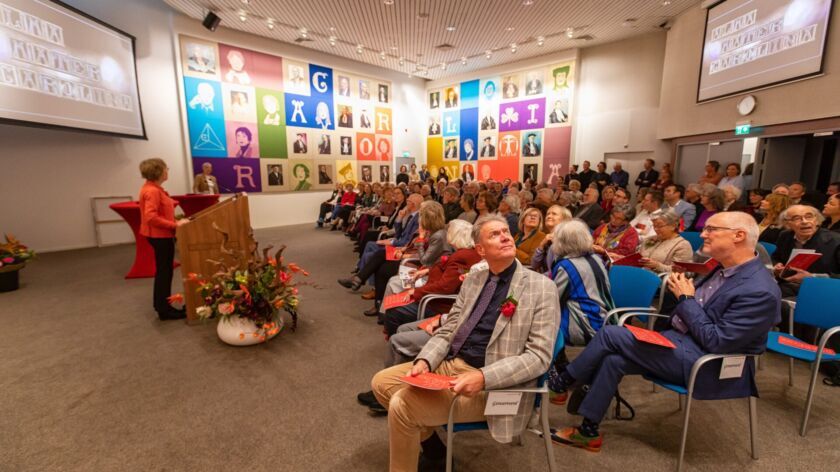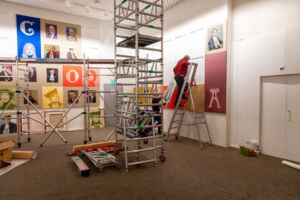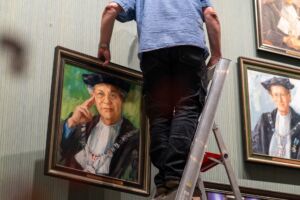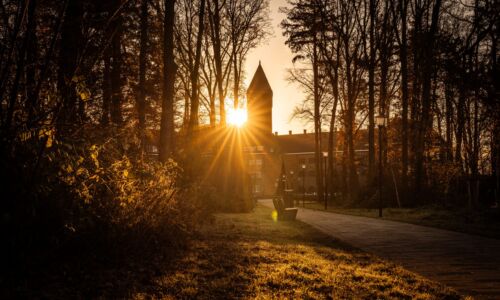How a film featuring Han van Krieken caused headaches: ‘Are we now being cancelled by our own executive board?’
-
 The opening of the renovated Senate Hall, 18 October 2023. Photo: Dick van Aalst
The opening of the renovated Senate Hall, 18 October 2023. Photo: Dick van Aalst
Amid the challenging times Radboud University faced last year, the decision was made to hold back the release of a documentary about the renovated Senate Hall. Concerns arose that it might stir controversy, given the role of the recently resigned rector Han van Krieken in the documentary. This weekend, however, the film will still make its debut during Open Monument Day.
October 2023. A small team from the Marketing & Communications division has gathered in the attic of the Berchmanianum around a screen. On the agenda is a preview of a teaser created by their colleague Dick van Aalst for his upcoming documentary.
Open Monument Day
Radboud University will open several buildings to the public during Open Monument Day (14 September). These include Huize Heyendael, the Huygens Building, Berchmanianum, the University Library, and the Aula. The documentary of Dick van Aalst about Alma Mater Carolina will be shown in the Senate Hall at 11:30 and 13:30.
His film is about Alma Mater Carolina, an artwork set to be revealed in the university’s Senate Hall a few weeks later, the day after the university’s centennial celebration. Van Aalst traveled to Los Angeles specifically to visit the studio of artist Lara Schnitger, alongside art coordinator Let Geerling.
White Men
The idea to transform the Senate Hall had been brewing for years. In 2021, Margot van Mulken and Lutgarde Buydens, at that time the only female deans at Radboud University, approached Rector Han van Krieken with the proposal to change the space, as they believed it could no longer remain in its current state.
The Senate Hall is a windowless space in the Aula of Radboud University, primarily used for academic ceremonies such as PhD defences and graduation ceremonies. In its previous state, 56 former rectors of the university – all white men in suits or robes – stared down from the walls under harsh fluorescent lighting.
The collection of portraits no longer aligned with the image that Radboud University, known for its commitment to diversity, wanted to carry out. Therefore a group photo of the university’s female professors was added to the wall in 2018. Although the photo was added at the request of a group of female professors, this ‘pubic photo’ only made it worse according to Van Mulken. The group portrait only accentuated the male-dominated history of the institution. It was clear a complete makeover was needed.
To her surprise, both she and her colleague Buydens quickly gained support from the university’s executive board. The executives themselves felt uncomfortable with the male-only portrait gallery. Rector Han van Krieken called in the university’s art advisory committee, and soon the project found its way to artist Lara Schnitger, who was commissioned to develop a plan for the room.
Unique Technique
Back to the Berchmanianum in October 2023: Van Aalst’s colleagues curiously watch as the photographer and filmmaker presses play. The film takes them to Schnitger’s studio in Los Angeles, where she explains the unique technique she used for the artwork. Using stencils and bleach, she transforms fabric into colorful, striking portraits of female emeritus professors. These portraits, based on photos sent to her, will be hung alongside the old portraits of former rectors.
Van Aalst’s film also features other key figures behind the new artwork, such as the initiators Margot van Mulken and Lutgarde Buydens. Rector Han van Krieken also appears, expressing his enthusiasm for the updated room, though emphasizing that the new artwork should respect the university’s history.

As the preview comes to an end, Marketing & Communications Director Pim van Zanen joins the group. ‘We shouldn’t go forward with this,’ he says firmly.
His decision is directly tied to the tense atmosphere at Radboud University at the time. A crisis team, which Van Zanen is part of, had been assembled and was meeting almost daily with the executive board. No one understood the sensitivity of the situation better than he did.
The crisis began when, just weeks before the centennial celebration, De Gelderlander revealed that in 2017, a complaint had been filed against rector Han van Krieken. The complaint accused him of making comments to a female staff member that, according to a committee investigating the matter, could be perceived as sexually inappropriate. The rector received a private warning.
As a result of the public revelation, Van Krieken was forced to step down as rector just before the centennial event. Instead of the celebration marking his tenure, the event became the occasion for the installation of José Sanders as the new rector, with no formal handover of the rector’s chain. The centennial celebration took on a completely different tone, and the unveiling of the renovated Senate Hall the following day was also affected.
Hitting the wrong note
In the midst of the controversy, Margot van Mulken and Lutgarde Buydens came to Van Krieken’s defense with an opinion piece on Voxweb. They questioned who stood to gain from such a public shaming. However, this stance hit a wrong note with dozens of university staff members, who argued that Van Mulken and Buydens’ position hindered an open discussion on campus about social safety.
As the debate intensified, the crisis team determined that, given the turmoil engulfing the university, a film about an artwork centered on emancipation—featuring Van Krieken, Van Mulken, and Buydens—could be poorly received. At the very least, it could distract from the art itself and fuel the ongoing heated debate about social safety.

Van Aalst was tasked with creating a much shorter version of the film, leaving out Van Krieken, Van Mulken, and Buydens. The final product was a brief trailer featuring only artist Lara Schnitger and university historian Jan Brabers, which was shown during the opening of the hall. The rest of the footage was shelved indefinitely
‘Of course I was angry, sad, and frustrated,’ Van Aalst reflects. But looking back, the filmmaker understands the decision. ‘The artwork is about emancipation and gender equality, which were incredibly sensitive topics at the time. Having Han van Krieken talk about that in the film simply wasn’t feasible. The debate around social safety was so polarized that anything said would immediately place you in one camp or the other.’
‘I thought: I have gold in my hands, regardless’, Van Aalst says. ‘Even if the film never sees the light of day, I would still be proud of it.’
Former Rectors
Does adding portraits of female emeriti among the former rectors distort history? Bas Kortmann, rector from 2007 to 2014, doesn’t want to go that far. ‘But it at least disrupts the timeline by placing abstract portraits among them. I understand the university wanted to do something with the space, but I would have chosen a different approach. The final result feels a bit messy to me.’
Kortmann also feels that the former rectors who are still alive should have been more involved in the creation of the new artwork. ‘After all, it was about our portraits. We had to find out from the media that the artwork was completed.’
He and the other former rectors were surprised to learn that their portraits had been removed from their original frames for the new installation. ‘It’s legally questionable to do that without the permission of the original portrait artists. Additionally, it is also debatable whether they could do it without our consent as the subjects.’
Overall, Kortmann regrets how the situation was handled, saying it doesn’t reflect the ‘open and respectful culture of our university.’ He adds, ‘As former rectors, we didn’t make a fuss about it last year. Drawing attention to such a relatively minor issue wouldn’t have been wise at the time.’
Margot van Mulken feels a lingering bitterness about how things unfolded. ‘Ten minutes before we entered the hall, we were told that we’d been cut from the film, despite being interviewed extensively by Dick van Aalst. We wondered if we were being canceled by our own board.’
Van Mulken still finds it hard to understand this decision. ‘The initiative for this room had nothing to do with the issue surrounding Han van Krieken.’
Tension
Han van Krieken, who had just stepped down as rector at the time, was present at the opening of the artwork in the revamped Senate Hall. It was there that he first saw his own portrait hanging on the wall. The debates about whether or how the film should be shown had passed him by. ‘I had other things on my mind at that time, and I was no longer the rector.’
He no longer had a place in the edited version of Van Aalst’s film. ‘I could understand the concerns about showing me. There was a sense of fear and tension at the university back then, where emotions overtook reason. I didn’t think that was the right approach.’
However, the fact that Van Mulken and Buydens were also cut from the film didn’t sit well with the former rector. ‘I really don’t get that — they had nothing to do with my situation.’
Van Krieken was also surprised by the relatively quiet way in which the opening of the new room was handled. The hall was full of those closely involved and family members of those portrayed, but the media presence was minimal. Only Marit Willemsen from NRC was there to cover the event, and she wasn’t officially invited.
‘The press releases and invitations to local and national media were ready,’ said Ton Rijken, chairman of the art advisory committee. ‘But they weren’t sent, as directed by the board.’ Even Vox wasn’t invited.
‘It deserved more attention,’ Van Krieken commented. ‘The artist took on a really tough question. The new artwork honors history while giving the room a modern twist. The result is inspiring and provokes reflection — like why it took the university so long to become a more diverse place. But that’s what good art does: it raises questions.’
Objection
It might go unnoticed by most visitors, but after the opening of the new Senate Hall, a change has already been made to Schnitger’s artwork. The widower of one of the portrayed female emeriti filed a complaint with the university. ‘He didn’t like the depiction of his late wife,’ explains Ton Rijken, who, along with Rector José Sanders, spoke with the man. After discussions with Schnitger, it was decided to replace the image with a blank canvas.
‘It’s a bit absurd to alter an artwork after the fact,’ Rijken admits. ‘But in another way, it’s also quite special. It’s a dynamic piece.’ He adds that changes will continue to happen, for instance, when José Sanders steps down as rector, her portrait will be added to the artwork.
The relative silence surrounding the artwork also troubles the art advisory committee. Chair Rijken comments, ‘What the university has done with this room is really special.’ He points out that all universities are grappling with the same issue – what do you do with all the portraits of old, white men on the walls? Nijmegen, according to Rijken, has found its own solution thanks to a renowned artist.
Last year’s opening of the room was the perfect moment to make a big statement about it, but the university let that opportunity slip by, he says. ‘It wasn’t a celebration, and there’s still very little buzz around the artwork. I feel especially bad for Lara Schnitger because of that.’
Schnitger herself calls it ‘a missed opportunity.’ While the room’s opening went ahead as planned, she felt the university wasn’t quite ready for her artwork. ‘It was like a soft launch, whereas the university should have been really proud of this project. What Radboud has done is actually very bold.’
Schnitger adds that everything became quite stressful at the last minute. It was only four days before the opening that she got the go-ahead to finish the artwork, including Han van Krieken’s portrait. ‘There was still some back-and-forth about that.’ The scaffolding was only just taken down in time for the opening.
Schnitger hopes the university will eventually showcase the room more publicly. Showing Van Aalst’s film is a good start, she believes. Rijken also sees signs of positive change, noting that soon the Friends of the Valkhof Museum will be visiting the room.
One person who is especially pleased that the film about Alma Mater Carolina is finally premiering, uncensored, is its creator. ‘The artwork captures how thinking at the university has evolved,’ says Van Aalst. ‘Personally, I find the motivation and inspiration of an artist often more fascinating than the end result. What sparks their creativity, and how do they translate that into their work? How does a piece of art come to life? I think we’ve done a good job of capturing that.’
Response from the Executive Board:
‘At the unveiling of the artwork on October 18, 2023 – a day after the university’s 100th anniversary and the installation of the new rector – a short trial version of the film, lasting a few minutes, was shown. To maintain balance, we chose to only include clips featuring artist Lara Schnitger and university historian Jan Brabers. The intention was to focus the conversation on the artist, the artwork itself, and the underlying message of diversity, rather than letting the discussion shift towards the ongoing social safety debate at the time.’
‘On September 18, 2023, the university published a news article with an open invitation and announcement on its website titled, ‘Senate Hall of Radboud University Gets a New Look‘. Marit Willemsen from NRC contacted me, as the university’s spokesperson, to ask if she could attend the event. She was welcome.’
‘The artwork Alma Mater Carolina includes portraits of all former rectors of Radboud University – all men – as well as thirty female professors from various faculties over time. The Executive Board commissioned this combination in the artwork to give the Senate Hall a more contemporary context, recognising both the university’s history and the importance of diversity.’
‘The social safety discussion, by the way, has been held many times and in many places across the campus— also during dialogue sessions organised at the request of the Executive Board – and those conversations will continue to happen.’
Translated by Siri Joustra



